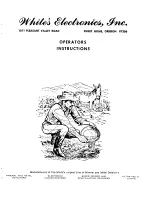
CS100 GB
8
FINE-TUNING THE DETECTOR
When you become familiar with how your detector works, you can fine-tune it
to make it more selective in what it finds.
Discrimination is the detector's ability to differentiate between types of metal.
The detector's
DISCRIMINATION
settings determines whether the detector will
distinguish between different types of ferrous and non-ferrous metals.
You can set
DISCRIMINATION
to minimum (fully anticlockwise), to maximum
(fully clockwise), or anywhere in between. As you set
DISCRIMINATION
to
higher levels, the detector first does not detect small pieces of silver paper,
then thick foil, and finally metal objects like pull tabs from aluminium cans.
Note :
Each time you use the detector in a different area, you must adjust
DISCRIMINATION
. Each search location presents new challenges.
FALSE SIGNALS
Because your detector is extremely sensitive, trash-induced signals and other
sources of interference might cause signals that seems confusing. The key to
handling these types of signals is to dig for only those targets that emit a
strong, repeatable signal. As you sweep the search coil back and forth over the
ground, learn to recognise the difference between signals that occur at random
and signals that are stable and repeatable.
To reduce false signals when searching very trashy ground, only scan a small
area at a time using slow, short overlapping sweeps.


































